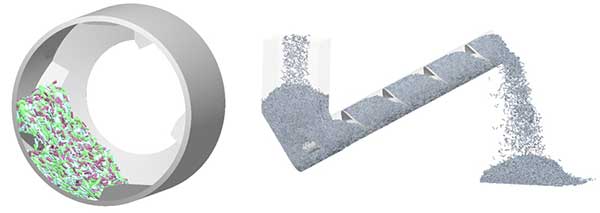
Examples using polyhedral particles: chewing gum in drum mixer and pellets in screw auger. Image courtesy of Altair.
Latest News
March 1, 2021
In the latest version of Altair EDEM 2021, shape plays a role in Discrete Element Method (DEM) simulations. For most applications, the well-validated multi-sphere approach is recommended as it offers the right balance of computational efficiency and accuracy, according to Altair. There are, however, some applications for which the use of polyhedral particles can be attractive. These include materials that have a uniform shape or those that require a large number of spheres to represent—such as particles with a high aspect ratio.
With EDEM 2021 users now have access to a new polyhedral particle shape solver as an alternative to the standard multi-sphere solver. The polyhedral particle solver has been designed for high-performance cards and runs on Nvidia CUDA GPU cards. It is compatible with the EDEM API and the coupling interface for coupled simulations with computational fluid dynamics (CFD) and multi-body dynamics solvers.
The EDEM multi-sphere GPU solver has been further optimized and this results in a speed improvement of up to 30%.
Volume Packing
The new ‘volume packing’ functionality in EDEM 2021 enables users to auto-generate tightly packed beds quickly and according to specific criteria such as porosity or a given level of compaction. This works for any closed volume geometry and can be applied to arbitrary shapes but also uniform shapes such as cylindrical hoppers. It is a faster method than the traditional way of introducing large amounts of material and, once generated, these beds are saved as material blocks that can be easily introduced at any time during a simulation or reused in other simulations, according to the company.
Built-in Lift and Drag Models
The ability to import a third-party data field for a one-way CFD coupling has been a key capability of EDEM for many years when looking at particle-fluid applications where the fluid drag is significant but the particle effect on fluid flow is not. The workflow has now been enhanced with the availability of a range of lift and drag models now available directly from the Physics section of the EDEM Creator, within the Particle Body Force dropdown. Users only need to import a velocity field and they will be able to select a model from the list, currently including:
- Saffman lift model
- Magnus lift model
- Schiller and Naumann drag model
- Morsi and Alexander drag model
- Haider and Levenspiel drag model
- Ganser drag model
User Workflow Enhancements
A range of enhancements have been made to improve and speed up the workflow. That includes the possibility to group several geometry parts and merge geometries, making it easier and faster to manage simulations with many parts. On the post-processing side, it is now possible to color particles by Stress, Axial Stress and Von Mises, to visualize stress and analyze damage directly in the EDEM Analyst. For usability and ergonomics, support for using a 3D mouse has been added with the option to use SpaceMouse products by 3dconnexion to modify the 3D viewer in EDEM.
Sources: Press materials received from the company and additional information gleaned from the company’s website.
Subscribe to our FREE magazine, FREE email newsletters or both!
Latest News
About the Author
DE’s editors contribute news and new product announcements to Digital Engineering.
Press releases may be sent to them via [email protected].
Related Topics
All topics



